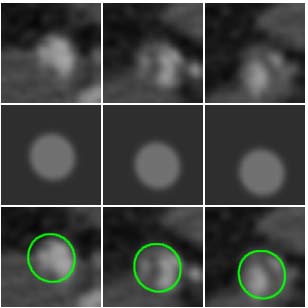Abstract
Accurate estimation of vessel parameters is a prerequisite for automated visualization and analysis of normal and diseased blood vessels. The objective of this research is to estimate the dimensions of lower extremity arteries, imaged by computed tomography (CT). The vessel is modeled using an elliptical or cylindrical structure with specific dimensions, orientation and blood vessel mean density. The model separates two homogeneous regions: Its inner side represents a region of density for vessels, and its outer side a region for background. Taking into account the point spread function (PSF) of a CT scanner, a function is modeled with a Gaussian kernel, in order to smooth the vessel boundary in the model. A new strategy for vessel parameter estimation is presented. It stems from vessel model and model parameter optimization by a nonlinear optimization procedure (the Levenberg-Marquardt technique). The method provides center location, diameter and orientation of the vessel as well as blood and background mean density values. The method is tested on synthetic data and real patient data with encouraging results.Keywords:Visualization, Segmentation, Diseased Blood Vessel Detection
Download full paper
Alexandra La Cruz, Matúš Straka, Arnold Köchl, Miloš Šrámek, Eduard Gröller, Dominik Fleischmann, "Non-linear Model Fitting to Parameterize Diseased Blood Vessels", in proceedings of IEEE Visualization 2004, pages 393-400. nlfm.pdf (3,330 KB)Figures in the paper
BibTeX Entry
@inProceedings{ALCVIS04,
title = "{{N}on-linear {M}odel {F}itting to
{P}arameterize {D}iseased {B}lood {V}essels},
author = "A. {La Cruz} and M. {S}traka and
A. K\"{o}chl and M. \v{S}r\'{a}mek and
E. Gr\"{o}ller and D. Fleischmann",
year = "2004",
pages = "393--400",
month = "oct",
location = "Austin, Texas",
editor = "IEEE",
booktitle = "IEEE Visualization 2004"
}
